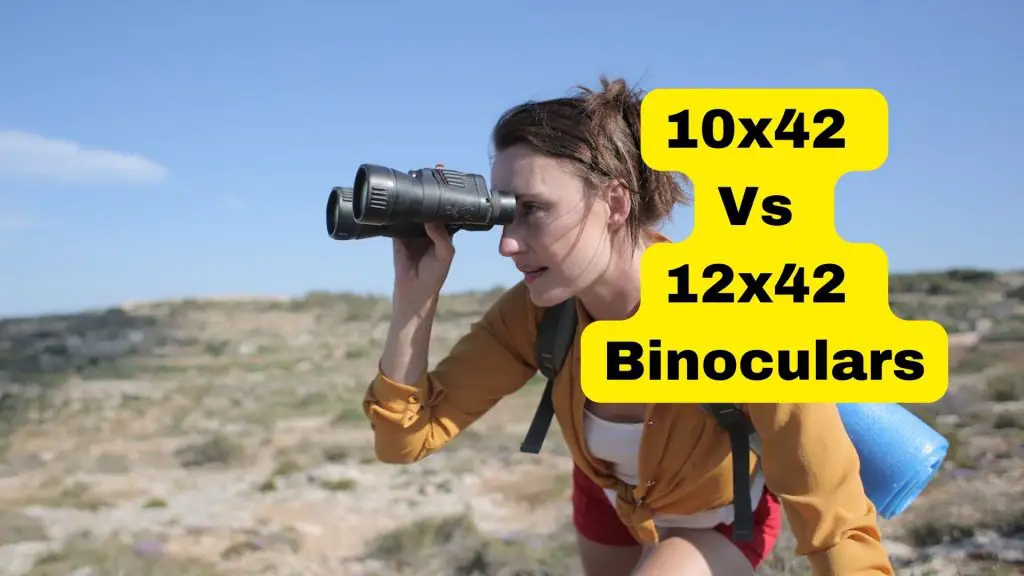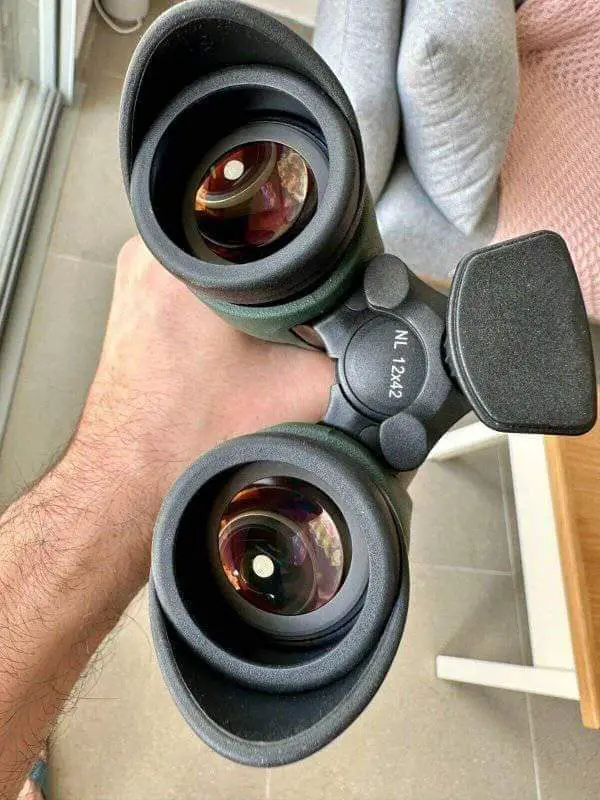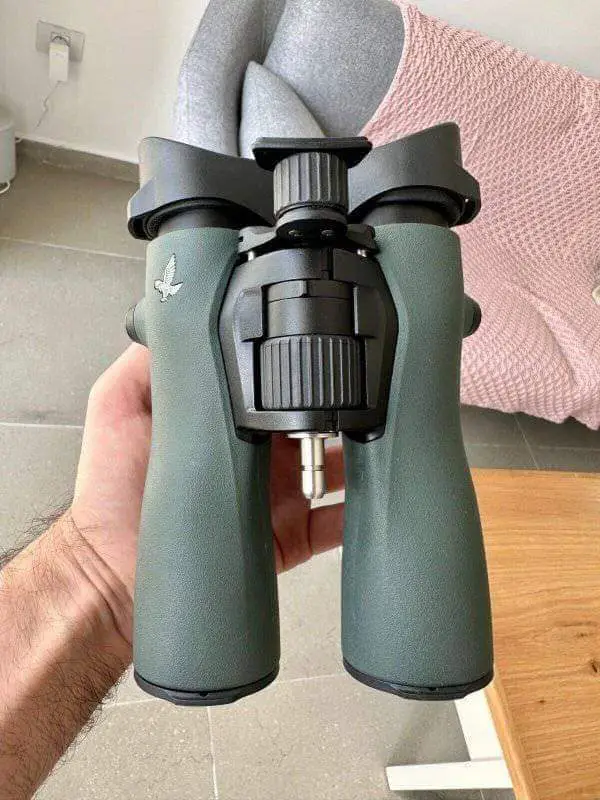10×42 Vs 12×42 Binoculars
If you click a link on this page and make a purchase, we may receive a small commission at no extra cost to you. Learn More
When it comes to choosing the right binoculars, one important factor to consider is the magnification power.
The 10×42 and 12×42 binoculars are two popular options, each with their own unique strengths and weaknesses.
In this discussion, we’ll explore the differences between these two types of binoculars and help you decide which one is the right fit for your job.
So, whether you’re a seasoned pro or a beginner, let’s dive in and discover which binoculars will help you see the world in a whole new way!

10×42 Vs. 12×42 Binoculars based on
- Magnification
- Exit pupil
- Twilight Factor
- Weight & Size
- FOV
- Price
Magnification
Magnification refers to the ability of a lens system to enlarge the image of an object. It is expressed as a number, which represents the factor by which the object is magnified. For example, a 10x magnification means that the object will appear 10 times closer than it would to the naked eye.
As the name suggests, 10×42 binoculars have a magnification of 10, while 12×42 binoculars have a magnification of 12. This means that 12×42 binoculars will provide a closer view of the object than 10×42 binoculars.
How Magnification Affects Image Quality and Stability
Higher magnification may seem like a better choice, as it allows you to get closer to the object and see more details. However, it also means that the image will be more shaky and unstable. This is because the slightest movement of the binoculars will be magnified as well, making it difficult to keep the image steady.
On the other hand, lower magnification provides a wider field of view, making it easier to locate and track objects. It also results in a more stable image, as the slightest movement of the binoculars will not be as noticeable.

Depth Of Field (DOF)
DOF is a term used in optics that refers to the range of distances in an image that appear acceptably sharp. In other words, it’s the area in front of and behind the subject that is in focus.
The 12×42 binoculars will typically have a shallower depth of field (DOF) than the 10×42 binoculars.
Let me elaborate:
Binoculars with higher magnification, such as the 12×42, will typically have a shallower DOF, which means that only a smaller range of distances will appear acceptably sharp. This can make it more challenging to focus on a moving object or to see multiple objects at different distances in sharp focus at the same time.
On the other hand, binoculars with lower magnification, such as the 10×42, will typically have a deeper DOF, which means that a larger range of distances will appear acceptably sharp. This can be beneficial for activities such as birdwatching or wildlife observation, where you may need to quickly switch focus between objects at different distances.
Exit Pupil
Exit pupil refers to the diameter of the beam of light that exits the eyepiece of a binocular. It is determined by dividing the objective lens diameter by the magnification.
For example, a 10×42 binocular has an exit pupil of 4.2mm (42mm divided by 10), while a 12×42 binocular has an exit pupil of 3.5mm (42mm divided by 12).
Comparison of exit pupil size between the two
When comparing the exit pupil size of 10×42 and 12×42 binoculars, the 10×42 has a larger exit pupil than the 12×42. This means that the 10×42 will provide a brighter image than the 12×42, especially in low light conditions.
Discussion of how to exit pupil affects image brightness and clarity
The exit pupil size is an essential factor to consider when choosing a binocular because it determines the amount of light that enters the eye.
A larger exit pupil allows more light to enter the eye, which results in a brighter image. In comparison, a smaller exit pupil may result in a darker image.
When choosing between a 10×42 and a 12×42 binocular, the exit pupil size is an important factor to consider. While a larger exit pupil will provide a brighter image, other factors such as magnification and field of view should also be considered.
Twilight Factor
The twilight factor is a measure of a binocular’s ability to gather light and produce clear & crisp images (Don’t confuse bright images with clear images) in low-light conditions.
It is calculated by taking the square root of the product of the objective lens diameter and magnification and is represented by a number. The higher the twilight factor, the better the binoculars’ low-light performance.
In a 10×42 binocular, the objective lens diameter is 42mm and the magnification is 10x, giving it a twilight factor of 20.5. In a 12×42 binocular, the objective lens diameter is also 42mm, but the magnification is 12x, giving it a slightly higher twilight factor of 25.9.
The 12×42 binocular has a higher twilight factor than the 10×42 binocular, which means it will produce better images in low-light conditions such as during dawn or dusk. This is because the higher magnification allows more light to be gathered by the objective lens, resulting in a brighter image.
Also, When choosing between a 10×42 and 12×42 binocular, the difference in twilight factor may not be significant enough to sway the decision on its own.
Other factors such as magnification, FOV, and weight should also be considered.
Note : In general, a twilight factor of 17 or higher is considered to be good for low-light conditions, but a higher twilight factor will provide even better performance. However, it’s important to note that other factors such as lens coatings and quality of optics can also affect low-light performance.

Weight and Size
In terms of weight, the 10×42 binoculars are generally lighter than the 12×42 ones. This is because the 12x magnification requires larger and heavier lenses to provide the same image quality as the 10x magnification.
As for the size, the 12×42 binoculars are usually slightly larger than the 10×42 ones due to the larger lenses.
Pros and Cons Considering size and Weight
The main advantage of the 10×42 binoculars is their lighter weight, which makes them easier to carry around for extended periods of time.
This makes them a great option for activities such as birdwatching, hiking, or hunting, where mobility is key. Additionally, the smaller size of the 10×42 binoculars makes them easier to pack and store.
On the other hand, the 12×42 binoculars offer a higher magnification, which can be beneficial for activities that require greater detail, such as wildlife observation or stargazing.
The larger lenses also provide a brighter and clearer image, making them better suited for low-light conditions. However, the increased weight and size can make them less comfortable to hold for extended periods of time.
FOV or Field Of View
The field of view (FOV) refers to the width of the observable area through a binocular lens. It is the extent of the image that can be seen at a given distance and is usually measured in degrees. A wider FOV means a larger area is visible through the binoculars.
The 10×42 and 12×42 binoculars have different magnifications, which affects their FOV. The 10×42 binoculars have a larger FOV compared to the 12×42 binoculars.
This is because a higher magnification results in a narrower field of view, making it harder to see objects in motion or follow moving targets.
For example, the Nikon Monarch M5 12×42 has a FOV of 267 feet at a distance of 1000 yards, while the Nikon monarch M5 10×42 has a FOV of 293 feet at the same distance.
Another example, the Swarovski 12×42 NL Pure Binoculars has a FOV of 339 feet at a distance of 1000 yards, while the Swarovski 10×42 NL Pure Binoculars has a FOV of 399 feet at the same distance.
How FOV Affects the viewing experience
A wider FOV provides a more immersive viewing experience, allowing you to take in more of your surroundings.
It is particularly useful for bird watching, sports, and nature observation. A narrower FOV can make it more challenging to find and track fast-moving objects, requiring more adjustments to follow a moving target.
Price
When it comes to buying binoculars, one of the biggest factors that can affect your decision is the price. Binoculars can range from very affordable to very expensive, and the price can depend on several factors.
Factors that can affect the price of binoculars, include the quality of the optics, the type of prism used, the durability and build quality of the binoculars, and the brand name. Additionally, features like waterproofing can also affect the price.
Comparison of the two prices for different quality levels:
When it comes to comparing the prices of 10×42 and 12×42 binoculars, it’s important to note that there can be often differences in quality between the two. For example, a 10×42 binocular may be priced lower than a 12×42 binocular of similar quality because the magnification is lower. Similarly, a 1ox42 binocular with additional features like waterproofing may be priced higher than a 12×42 binocular without these features.
In general, you can expect to pay more for a 12×42 a 10×42 binocular of a similar brand or configuration. In my experience however, the price difference is not more than 5-10%.
For example, Nikon monarch m5 10×42 costs around $266, while Monarch M5 12×42 costs $286 at the time of writing this article. The 12×42 is dearer by 7% than the 10×42 here.
It’s important to find a binocular that fits your budget while also providing the features and quality you need to have a satisfying viewing experience.
Which Should You choose : 10×42 or 12×42?
Let see the suitability of 10×42 and 12×42 binoculars for different activities:
Birding:
Both 10×42 and 12×42 binoculars can be suitable for birding, but if you prefer a wider field of view, the 10×42 binoculars may be a better choice. However, if you want more magnification and detail, the 12×42 binoculars may be a better fit for you.
Note: Binoculars that have lower magnification, such as the 10×42, tend to provide a wider depth of field. This means that a greater range of distances will appear in focus, making it easier to quickly shift focus between objects at varying distances. This feature is particularly advantageous for activities such as birdwatching and wildlife observation, where objects are often in motion and at varying distances.
Hunting:
The 12×42 binoculars may be a better choice for hunting as they offer greater magnification, allowing you to spot targets at greater distances. However, keep in mind that higher magnification can make the image shakier, so you may need to use a tripod or other stabilization equipment.
Hiking:
For hiking, the 10×42 binoculars may be a better choice as they are generally more compact and lightweight than the 12×42 binoculars. This can make them easier to carry on long hikes.
Sports Events:
Both 10×42 and 12×42 binoculars can be suitable for sports events, but the 10×42 binoculars may be better if you want a wider field of view and a better ability to track moving subjects.
Marine:
The 12×42 binoculars may be a better choice for marine activities as they offer greater magnification and detail, allowing you to spot buoys, markers, and other navigational aids from greater distances. However 12×42 might not be stable as 10×42. If you want to use without a base or tripod than 10×42 would be better in marine spotting.
Concerts:
For concerts, the 10×42 binoculars may be a better choice as they are generally lighter and more compact than the 12×42 binoculars, making them easier to carry and use for extended periods of time.
Wildlife Safari:
Both 10×42 and 12×42 binoculars can be suitable for wildlife safari, but the 12×42 binoculars may be better if you want greater magnification and detail for spotting distant animals.
However, the 10×42 binoculars may be better for tracking moving animals and birds. As already discussed, 10×42 would have better DOF, they can be preferred over 12×42 binoculars.
An Interesting Video:
Conclusion
Both the 10×42 and 12×42 binoculars are great choices for anyone looking for a high-quality, powerful set of binoculars for their outdoor activities.
The 10×42 binoculars offer a wider field of view and are generally more stable, while the 12×42 binoculars provide greater magnification and detail.
Also Check: 8×42 vs 10×42 Binoculars- Which One To Choose?
We hope this discussion has helped you understand the key differences between these binoculars and has given you the information you need to make an informed decision.
